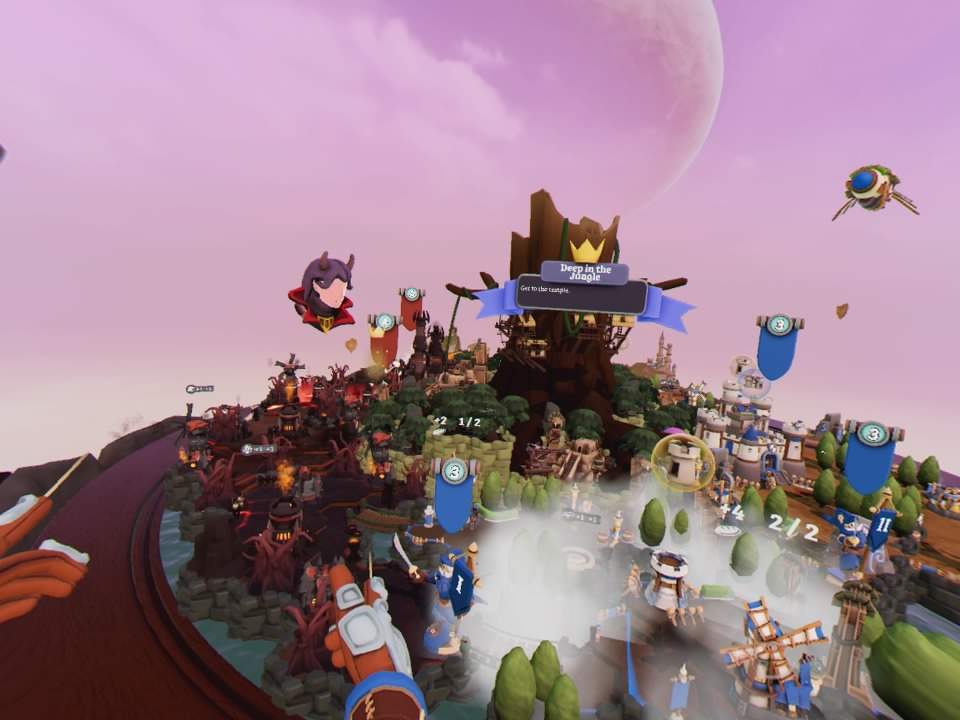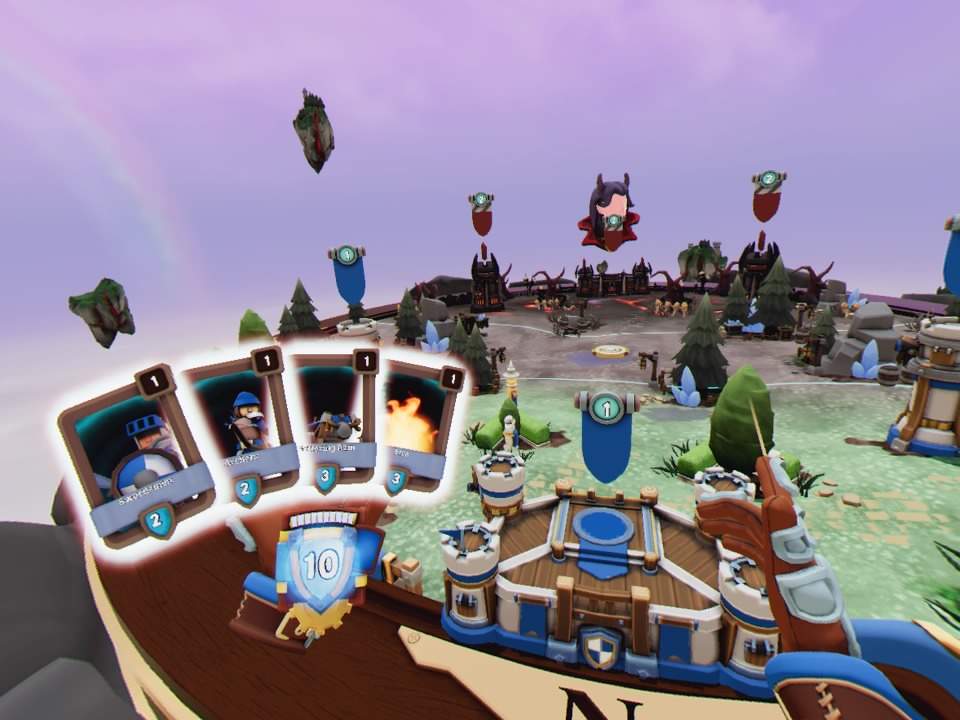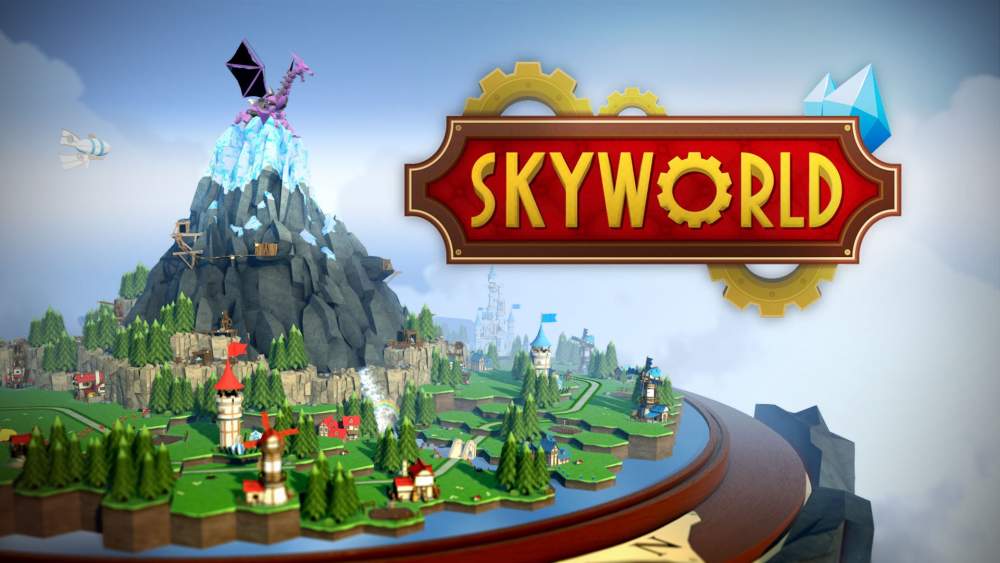Strategy games are sadly few and far between on PSVR, yet the platform is perfect for it. Trading in the gamepad for a pair of Move controllers that enable easy object manipulation work wonders, and Skyworld by Wolfdog Interactive and Vertigo Games is one of those few games that gets it spot on when it comes to VR’s controls.
What is Skyworld?
Skyworld is a really quirky title. Mixing multiple genres and styles of gameplay, it creates a layered and complex experience. You have city building, resource management, deck building and real-time combat all thrown into the mixing pot.
The end result is a very novel game that is easy to play, but increases in strategic depth when all the options have been opened up to you. The aim of the game is to protect Skyworld and battle back hordes of demons as you protect the various realms from the army of darkness. You must use your wits, your resources and your tactical nous to prevail.

Skyworld Modes and Features
Skyworld’s campaign also serves as a tutorial, as you slowly unlock new features and options. Guiding you through the games many systems and how to use them, it has a light story to follow that is neither gripping or unique but it serves its purpose.
You can also play skirmishes if you want to get quickly into some action. You can pick your options, battle arena and just get straight into it. Also available are daily challenges which give you XP and help raise your level. Online multiplayer is also a feature, but due to me playing before release I could not find a match. Consequently, this review and score takes into account single-player only.
Gameplay Loop
So what’s Skyworld actually like? Well, most of the time it acts as a city builder with a slight chess mechanic on top. It’s turn based, which means you can take your time with your decisions and mull things over. You take your turn, build your buildings and collect resources. You use these resources to build more buildings and expand.
When you are ready you create a general, this acts like a chess piece to be moved around the board and take new regions of the map. The general also acts as your army location and when you reach the opponent’s generals or occupied regions you can attack.
I Always Wanted to Work in HR
It sounds simple and it is really. However, attached to this are various systems that all have to be managed and tweaked to try and turn the tide of battle in your favour. You start with a small workforce, so you can only man a few buildings at once. Moving staff around at this point to where they are required is vital.
However, you can raise or lower your taxes and rations to change your occupant’s happiness. This increases or decreases your population each turn depending on your choices. This is a system that has to be constantly managed – you need a bigger workforce but you also need to be able to sustain them. Sometimes you need money so you raise your taxes, and sometimes you need more people so you raise rations and lower taxes.
It’s a great system that works really well. I often fell foul of this though and had some harsh lessons early on. Fortunately, I came out the other side educated and with my lesson learned.

Deck Building
Your army and its proficiency in battle are governed by a card system, not too different from the many card battle games on the market at the minute. You use the resources you have gained from your building exploits and research new cards. These cards take the form of grunts, archers, swordsman or even magical powers such as a fireball or a freeze spell. These are the units you will be taking into battle when it arises so your choices and resource allocation are vital to success.
These cards can also be upgraded using your resources too. They can be upgraded three times each, each level providing increases in health, attack power, speed and even duration of a spell. Upgrading your cards is so important too: I failed many battles by being unprepared. Other systems also hinge off this deck building too, as your army takes a health decrease for every card under the value of eight you have. So, you need to try and maximise your army as quickly as you can and build up your forces.
To the Battleground
When your general occupies the same space as an opponent general or an occupied tower you will be thrown into battle. This is where the game comes alive. It morphs into a real-time Hearthstone Command and Conquer hybrid and it’s brilliant. You are presented with a circular battleground, you on one side and your opponent on the other.
On your left hand you have four cards currently at your disposal. These all have mana costs and your mana pool builds up over time. These cards are the first four cards you have selected when building your deck, and they are replaced as you use them by the other cards you have researched. So once again your deck building has ramifications other than what units are at your disposal.
Your goal is to destroy your opponents base using your army. You throw your cards onto the battleground and as long as you have enough mana they will appear and go on the offensive. Each side has several towers, and their level is governed by the level of your general before the battle begins. In the middle of the map are points to claim that activate turrets. These points should be your first port of call as they help massively in the battle towards destroying the towers and your opponents base.
The whole battle system is superb, you really see what you have worked on in the building part of the game come to life. It’s a great battle system that promotes strategy, managing your mana and benefits players who have managed their resources better. It’s easy to play, works flawlessly and has hidden depths to explore.

Amazing Presentation
The best thing about Skyworld is its presentation and VR implementation. You can tell that a lot of time and effort has been put into this title. The graphics are beautiful, chunky, bright and very clear. The whole game has a cartoony look to it and the battlegrounds, worlds and all the various assets are beautifully designed. It is one of the prettiest VR titles I have played. It was a joy to be part of this world I was protecting.
The UI and the games way of moving between screens is some of the best VR implementation I have ever seen. If you hold the move button down you are presented with your various screens: Resources, cards, and building menus. When you grab one it opens a dialogue box showing its options. This dialogue box can then be placed anywhere in the VR space and it will stay there.
This means you can virtually create your own UI, wherever you want it to suit your play style. It’s amazing. I have not seen anything like it in VR, ever. It’s superb.
On your location menu you have a toggle lever. This enables you to move between the building area, your castle, your research lab and the blacksmith. When you move the toggle the whole game space rotates, the table top flips and you are presented with your new area. It’s brilliant. Whoever thought out this whole system deserves a medal.
In all screens, the whole play area can be moved and rotated by grabbing the table’s edge. It works very well and really helps you manoeuvre around the various battlefields. All this combined with the floating UI boxes makes for a very pleasurable VR experience. It’s like no other I have played and it’s really refreshing to use something so well designed.
So Tactile
Skyworld does keep throwing things at you that really shows how much the developer has thought about the VR experience. For instance, to destroy buildings you grab a hammer from your building dialogue box and actually hit the buildings. It’s like a VR whack-a-mole and it feels great. To upgrade your towers, castle or commission a new general you actually have to stamp a contract, with a stamp in your other hand. It all feels immersive and very tactile and really shows off the advantages of VR.

The Sounds of War
The sounds surrounding you on the battlefield are very good, the clashing of swords, the chants of your soldiers are all well realized. The music, however, is unfortunately unremarkable. It does its job keeping you grounded in the game, but it’s just not unique enough to remember or really enjoy.
An Amazing VR Experience
Performance-wise Skyworld is near perfect. Due to its incredibly well designed, moveable UI and screen changing mechanics, I was rarely lost in the VR space. Quite often on PSVR you struggle to find the right position or have to muddle through certain points due to bad game design and the camera limitations. None of that is present here and the whole experience is superb.
I had zero issues with framerates, bugs or glitches and the whole experience was a joy. There is nothing worse in a VR game than a poor implementation of VR. If it’s cumbersome and hard to play it breaks the immersion and it can become tiresome. That’s definitely not the case here.
Summary
Without a shadow of a doubt, Skyworld has one of the best UI’s and VR implementations I have ever used. It’s simple to use, it’s incredibly designed and its multiple different styles mesh together nicely to create a fun, strategic game that’s extremely enjoyable. If you like strategy titles, city building and resource management, it’s a must-buy for PSVR owners,and with its daily challenges and online mode you should give you quite a bit of bang for your buck.
